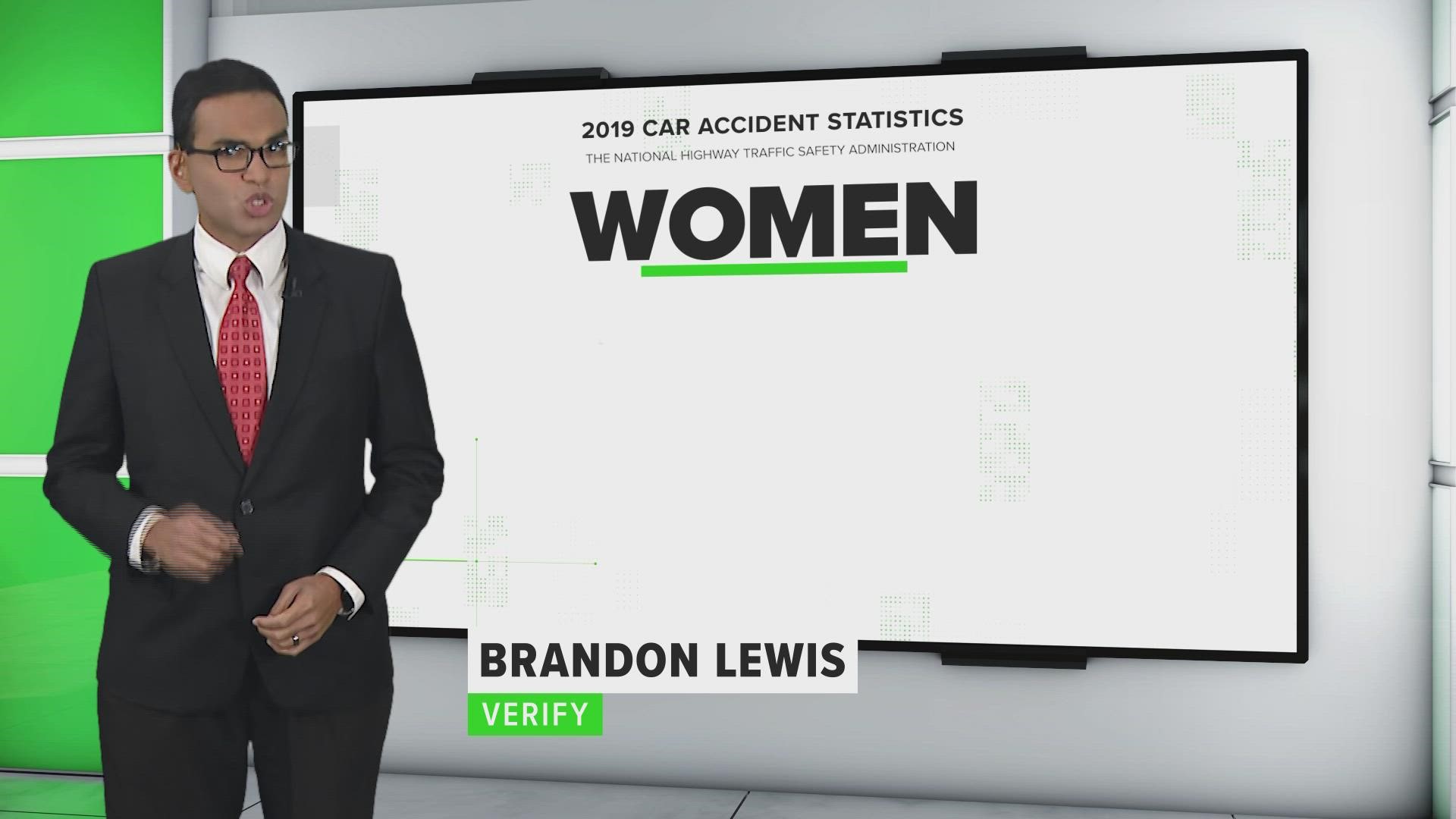An Instagram post from The Female Quotient, a “female-owned business advancing equality in the workplace” sparked conversation since it was posted on Sept. 28. The Instagram account has more than 251,000 followers.
The post, with more than 8,500 likes and hundreds of comments, said men are more likely to cause crashes, “but women are more likely to die in them.” Why? “Safety agencies don’t use female mannequins in many test collisions,” The post claims.
This is a complicated claim to analyze. The VERIFY team broke down two questions: Are men more likely to cause crashes than women, and are women more likely to be injured or killed because of male crash test dummies.
QUESTION 1
Are men more likely to cause crashes than women?
THE SOURCES
THE ANSWER
Yes, according to the National Highway Traffic Safety Administration, men cause more crashes than women, but the statistics involving crash and fatality rates need more context.
WHAT WE FOUND
Data from the National Highway Traffic Safety Administration (NHTSA) shows from 1975 to 2019, men were involved in more crashes than women. The data showed the driver-involvement rates per 100,000 licensed drivers 16 and older, by sex and crash severity.
The Insurance Institute for Highway Safety (IIHS) also reported, based on data from the U.S. Department of Transportation’s Fatality Analysis Reporting System (FARS), that historically, more men have died each year in motor vehicle crashes.
“Men typically drive more miles than women and are more likely to engage in risky driving practices, including not using safety belts, driving while impaired by alcohol, and speeding. Crashes involving male drivers often are more severe than those involving female drivers,” the report said.
In 2019, 71% of those killed in crashes were men, the NHTSA told VERIFY in an email.
It is also true 72% of women are more likely to be injured in a car crash, and 17% more likely to die if they get into the same crash as a male counterpart.
Which takes us to our next question.
QUESTION 2
Are women more likely to get injured or killed in a crash because crash test dummies are “optimized for male bodies”?
THE SOURCES
- Insurance Institute for Highway Safety
- National Highway Traffic Safety Administration
- Humanetics, the largest manufacturer of crash test dummies
THE ANSWER
Chris O’Connor, president and CEO of Humanetics, told VERIFY that safety tests are biased against women, as more tests are done using male crash test dummies. But there are other factors to consider when it comes to female fatality rates, like types of vehicles, where a woman sits in the car, and the type of crash.
WHAT WE FOUND
Female crash test dummies are used in some Federal Motor Vehicle Safety Standards (FMVSS) tests, but they are old designs developed 40 years ago, Chris O’Connor, president and CEO of Humanetics, told VERIFY in an email.
Humanetics is the largest manufacturer of anthropomorphic test devices (ATDs), commonly known as crash test dummies.
“The female ATDs in regulation and [New Car Assessment Program] NCAP tests are essentially scaled-down men, and do not have sensors that detect women’s unique injury profile,” O’Connor said, making crash safety tests biased against women.
IIHS Vice President of Vehicle Research Jessica Jermakian told VERIFY while crash test dummies are sophisticated tools, “they’re not so sophisticated that they are able to represent those organ tissues, bone level differences between men and women.”
When asked if the death rate between men and women could be directly attributed to the modeling of crash test dummies, Jermakian said, “the short answer is, we don’t have all the answers.”
“But in some research that we've done, we know that some of those studies from the past haven't always fully separated the physiological differences between men and women from other differences in men and women's crashes that can affect outcomes,” she said.
“Things like the types of vehicles that they drive, where they sit in the car, the types of crashes they get in and all of those things can affect injury risk. For example, women are more likely to drive things like passenger cars, while men are more likely to drive pickup trucks. But even within the same vehicle type, say SUVs, women are more likely to choose smaller, lighter ones, and men are more likely to choose heavier ones. And those differences can affect injury risk in a crash,” she said.
Women’s unique physiology (bone density, muscle structure, fat distribution, chest and abdomen) means that 51% of the population is not properly represented by using a default male crash test dummy, O’Connor told VERIFY.
Female crash test dummies were introduced in 2003, and male crash test dummies were exclusively used for decades prior, according to the NHTSA.
The NHTSA told VERIFY in an email they do use male and female crash test dummies in various modes in their safety tests and computer simulations, and include belted and unbelted configurations. Examples include:
- 5th percentile female dummy in the driver’s seat and front passenger’s seat in the full-frontal crash test that simulates a head-on collision between 2 vehicles.
- 50th percentile male dummy in the driver’s seat and front passenger’s seat in the full-frontal crash test that simulates a head-on collision between 2 vehicles.
- 5th percentile female dummy in the driver’s seat and front passenger’s seat in the 40% offset frontal crash test that simulates a head-on collision with partial overlap between 2 vehicles.
On the NHTSA’s website, there is a list of crash test dummies used in regular testing or simulations, including a 5th percentile adult female 4 feet and 11 inches tall, weighing 108 pounds, and also a small adult female, also at 4 feet and 11 inches tall, weighing 97 pounds.


In the email to VERIFY, the NHTSA only described various test modes using the 5th percentile dummy.
Jermakian told VERIFY that the test dummies are not as sophisticated yet, and there is new test dummy technology available to better represent women, but “the question is whether it will drive the improvements that will better protect women in future crashes.”












